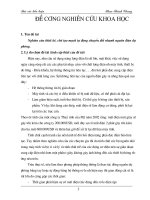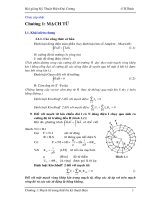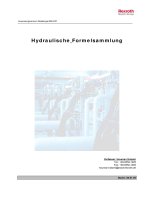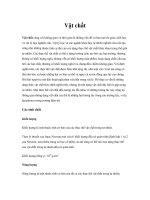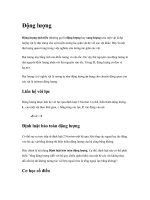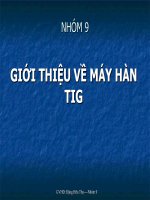Tài liệu Diploma Thesis docx
Bạn đang xem bản rút gọn của tài liệu. Xem và tải ngay bản đầy đủ của tài liệu tại đây (2.25 MB, 108 trang )
Parameter Studies of a Machine Feed
Axis Testbed in Time Domain by
Application of Multibody Simulation
Diploma Thesis
cand. ing. Juan Francisco Sánchez Alacid
wbk
Institut für Produktionstechnik
Universität Karlsruhe (TH)
Kaiserstraße 12
D-76131 Karlsruhe
Prof. Dr.-Ing. J. Fleischer
Prof. em. Dr.-Ing. H. Weule
wbk
Institut für Produktionstechnik
Universität Karlsruhe (TH)
Kaiserstraße 12
76131 Karlsruhe
Prof. Dr.-Ing. J. Fleischer
Prof. em. Dr.-Ing. H. Weule
Diploma Thesis (Diplomarbeit)
for Mr. cand. ing. Juan Francisco Sanchez Alacid, Matrikelnr. 1339071,
Brazal de la terraza, Nº 18, Patiño (Murcia), Spain
Parameter Studies of a Machine Feed Axis Testbed in Time Domain by
Application of Multibody Simulation
The productivity of a machine tool is determined by its dynamical properties. Hence, it is important to
determine those properties as early as possible when designing a new product. Because machine
tool manufacturers are forced by an increasing competition to reduce the time to market, virtual
prototypes can be used for simulation of the machine tool behavior instead of building and testing
cost-extensive physical prototypes.
Since a large variety of parameters, such as component stiffness or damping of guides, couplings,
ball screw drives and the like, influence the machine tool’s behavior, the influence of those
parameters has to be studied. To avoid extensive and expensive hardware testing, simulation is
ideally suited to investigate a large number of different parameters and their importance.
The aim of this thesis is to investigate the dynamic behavior of a machine tool feed axis testbed by
application of multibody simulation to study the effects of parameter variations in time domain. The
following tasks have to be carried out:
• Illustration of the theoretical background of multibody simulation and parameter varation,
• modeling and simulation of the testbed with a multibody simulation tool,
• validating the model with experimental data
• simulation of parameter variations.
Interne Nr. der Arbeit:
Tag der Ausgabe:
Tag der Abgabe:
Betreuer:
WHT-
02.07.2007
21.12.2007
Dipl.-Ing. Alexander Broos
Karlsruhe, 03.12.2007
___________________________
Prof. Dr.-Ing. Jürgen Fleischer
Declaration of Autonomy
wbk
Institut für Produktionstechnik
Juan Sanchez
Declaration of Autonomy
Herewith I confirm that I wrote this report on my own without using any forbidden help. All the addi-
tives I used are completely listed in the bibliography. I marked everything that I absorbed from other
papers with or without changes.
Karlsruhe, 21.12.2007
__________________________
Juan Francisco Sánchez Alacid
Acknowledgements
wbk
Institut für Produktionstechnik
Juan Sanchez
Acknowledgements
First of all, I would like to thank Dipl.-Ing. Alexander Broos for his trust in me to realize this thesis,
despite my difficulties with the English and German language. Without his support, it would have
been impossible for me to create my thesis. Dipl.-Ing. Alexander Broos was always there when I had
questions or any kind of problems and I want to thank him for his encouragement, support and
patience.
I would also like to express my gratitude to Mr Xavier Rosel. He spent a lot of time helping with the
English during the large period of the realization of this thesis.
Last but not least, I want to thank my parents, Juan Sánchez and Paquita Alacid. Without their
support and help, it would have been impossible for me to finish my studies.
Thanks!
Table of Contents
wbk
Institut für Produktionstechnik
Juan Sanchez
Table of Contents
LIST OF FIGURES VI
LIST OF TABLES IX
NOMENCLATURE X
ABBREVIATIONS XIII
1 INTRODUCTION 1
1.1 Motivation...........................................................................................................1
1.2 Objetive..............................................................................................................1
1.3 Structure of this Thesis......................................................................................2
2 THEORETICAL BACKGROUND 3
2.1 Machine Tool Behavior......................................................................................3
2.1.1 Static Behavior.......................................................................................3
2.1.2 Kinematic Behavior................................................................................3
2.1.3 Dynamic Behavior..................................................................................4
2.2 Dynamics of Multibody Systems.....................................................................11
2.2.1 Rigid Body Kinematics.........................................................................11
2.2.2 Kinetic..................................................................................................16
2.3 Software...........................................................................................................18
2.3.1 Catia V5...............................................................................................18
2.3.2 MSC.ADAMS........................................................................................20
3 STATE OF THE ART 27
3.1 Modelling in the Mechanics Field.....................................................................27
Table of Contents
wbk
Institut für Produktionstechnik
Juan Sanchez
4 INDIVIDUAL APPROACH AND PROCCEEDING 29
4.1 Individual Approach.........................................................................................29
4.2 Proceeding.......................................................................................................29
5 BUILDING THE MODEL 31
5.1 Original Model and Simplified Model................................................................31
5.2 Modeling the Mechanics..................................................................................33
5.2.1 Processing the CAD-Model...................................................................34
5.2.2 General Remarks on Modeling..............................................................35
5.2.3 Modeling of Transmission Parts............................................................38
5.3 Setting the Analysis Tools................................................................................44
5.3.1 Developing the Time Domain Analysis..................................................44
5.3.2 Developing the Frequency Domain Analysis.........................................45
5.3.3 Preparing the Parameter Analysis.........................................................47
6 RESUTLS 51
6.1 Relation of the Results with Previous Thesis...................................................51
6.2 Simplified Model Results with the Calculated Parameters...............................52
6.3 Parameter Variation Influence.........................................................................54
6.3.1 Coupling Influence on the Rigid Model..................................................55
6.3.2 Parameter Variation Influence on the Simplified Model........................61
6.3.3 Discussion of the Results......................................................................72
7 SUMMARY AND OUTLOOK 78
7.1 Summary..........................................................................................................78
7.2 Outlook.............................................................................................................79
Table of Contents
wbk
Institut für Produktionstechnik
Juan Sanchez
APPENDIX 80
A Correspondence between the simplified and the original model parts.......................80
B Name of the parts in Catia and in ADAMS.................................................................81
C Mass and mass inertia tensor properties....................................................................82
D Joints in the elastic model...........................................................................................82
Aditional joints in the rigid model................................................................................84
E Flexible Joints.............................................................................................................85
F Forces.........................................................................................................................86
G Spline values of the Motor Torque in time domain.....................................................87
H Modeling the Friction..................................................................................................88
BIBLIOGRAPHY 91
List of Figures
wbk
Institut für Produktionstechnik
Juan Sanchez
List of Figures
Figure 2.1: Ilustration of a single degree of freedom system [Stephenson-2006]................................5
Figure 2.2: Representation grafic of the free vibration fo an SDOF system with
ζ
<1........................6
Figure 2.3: Response curves.(a) Compliance/amplitude versus frequency.
(b) Phase versus frequency[Stephenson-2006] ...............................................................8
Figure 2.4: Body and inertial frame references [Shabana-2005a].....................................................11
Figure 2.5: Rotation of the coordinate system [Shabana-2005a].......................................................13
Figure 2.6: Spatial joints [Shabana-2005b]........................................................................................15
Figure 2.7: Catia environtment .........................................................................................................18
Figure 2.8: Hierarchical structure defined in tree structure................................................................20
Figure 2.9: Step in modeling and simulation in ADAMS/View [MSC-2005b]......................................22
Figure 2.10: ADAMS/View Toolbox...................................................................................................23
Figure 2.11: Process to realize an analysis with ADAMS/Vibration [MSC-2002b]..............................26
Figure 5.1: Testbed front [Hennrich-2007]........................................................................................31
Figure 5.2: Testbed rear [Hennrich-2007].........................................................................................32
Figure 5.3: Simplified model..............................................................................................................33
Figure 5.4: Orientation of the model in ADAMS/View........................................................................35
Figure 5.5: Definition of the Friction in the ADAMS/View Function Builder .......................................41
Figure 5.6: Point measure window....................................................................................................44
Figure 5.7: Simulation control window...............................................................................................45
Figure 5.8: Input channel window......................................................................................................46
Figure 5.9: Output channel window...................................................................................................46
Figure 5.10: Vibration analysis window..............................................................................................47
Figure 5.11: Building a Vibration Multi-Run Script in ADAMS............................................................48
List of Figures
wbk
Institut für Produktionstechnik
Juan Sanchez
Figure 5.12 : defining the objective....................................................................................................48
Figure 5.13: defining the Ojetive Macro.............................................................................................49
Figure 5.14: Design Evaluation Tools window in ADAMS..................................................................49
Figure 5.15: building a Simulation Script for the time domain............................................................50
Figure 6.1: frequency response in the X-axis of the simplified model................................................52
Figure 6.2: frequency response in the X-axis of the original model...................................................53
Figure 6.3: displacement of the Table in the X-axis...........................................................................53
Figure 6.4: acceleration of the Table in the X-axis............................................................................54
Figure 6.5: displacement difference between the rigid coupling and an elastic coupling
with different stiffness values..........................................................................................55
Figure 6.6: displacement difference between undamping coupling and a damping coupling.............57
Figure 6.7: differences increase between displacement with different damping values
and its relation with the speed........................................................................................57
Figure 6.8: frequency response of the X-axis displacement of the Table.........................................58
Figure 6.9: frequency response of the X-axis acceleration of the Table............................................59
Figure 6.10: frequency response of the displacement of the Table in X-axis with
a damping value of 2 Newton-mm-deg/sec....................................................................59
Figure 6.11: frequency response of the Table acceleration in X-axis with
a damping value of 2 Newton-mm-deg/sec...................................................................60
Figure 6.12: Friction influence on the X-axis displacement of the Table in the frequency domain.....61
Figure 6.13: Friction influence on the X-axis displacement of the Table in the time domain..............62
Figure 6.14: axial stiffness influence of the bearings on the X-axis of the Table..............................63
Figure 6.15: coupling stiffness influence on the X-axis of the Table..................................................63
Figure 6.16: coupling damping influence on the X-axis of the Table.................................................64
Figure 6.17: displacement difference between different stiffness values of the DOE
and the standard value in the coupling...........................................................................65
List of Figures
wbk
Institut für Produktionstechnik
Juan Sanchez
Figure 6.18: displacement difference between different stiffness values of the DOE
and the standard value in the coupling...........................................................................66
Figure 6.19: ball screw stiffness influence on the X-axis of the Table...............................................66
Figure 6.20: ball screw damping influence on the X-axis of the Table...............................................67
Figure 6.21: displacement difference between different stiffness values of the DOE
and the standard value in the ball screw........................................................................68
Figure 6.22: displacement difference between different damping values of the DOE
and the standard value in the ball screw........................................................................68
Figure 6.23: linear guide translational stiffness influence on the X-axis of the Table.........................69
Figure 6.24: linear guide translational damping influence on the X-axis of the Table........................70
Figure 6.25: linear guide rotational damping influence on the X-axis of the Table.............................70
Figure 6.26: translational stiffness influence of the linear guides in the displacement
Z-axis of the Table.........................................................................................................71
Figure 6.27: resonance found in the frequency domain results.........................................................74
Figure A.1: Motor Torque in time domain..........................................................................................87
Figure A.2: Coefficient of friction varying with slip velocity [MSC-2005b]...........................................89
Figure A.3: Definition for the Step function [MSC-2005b]..................................................................90
List of Tables
wbk
Institut für Produktionstechnik
Juan Sanchez
List of Tables
Table 2.1: Vibrations in machine tools [Weck-2002]............................................................................9
Table 5.1: values Klotzbuecher [Kotzbuecher-2007]....................................................................36
Table 5.2: Bearings stiffness value [Kotzbuecher-2007]....................................................................38
Table 5.3: Bearing damping value [Kotzbuecher-2007].....................................................................39
Table 5.4: Ball screw stiffness and damping values [Kotzbuecher-2007]..........................................40
Table 5.5: Linear guide stiffness values [Kotzbuecher-2007]............................................................42
Table 5.6: Linear guides damping values [Kotzbuecher-2007]..........................................................42
Table 5.7: Coupling stiffness und damping values [Kotzbuecher-2007]............................................43
Table 6.1: summary of the results of the elastic model in frequency domain.....................................74
Table 6.2: summary of the results of the elastic model in time domain.............................................76
Table A.1: Correspondence between the simplified and the original model parts..............................80
Table A.2: Name of the parts in Catia and in ADAMS.......................................................................81
Table A.3: Mass and mass inertia tensor properties..........................................................................82
Table A.4: Joints in the elastic model................................................................................................82
Table A.5: Aditional joints in the rigid model......................................................................................84
Table A.6: Flexible Joints..................................................................................................................85
Table A.7: Forces..............................................................................................................................86
Table A.8: Spline values of the Motor Torque in time domain...........................................................87
Nomenclature
wbk
Institut für Produktionstechnik
Juan Sanchez
Nomenclature
transformation matrix
non-holonomic constrains coefficient
c viscous damping coefficient
stiffness in i-axis
[ ]
damping matrix
damping in i-axis
Lehr`sches damping factor
external force
Fourier transform of
forces in rigid bodies
frequency response function
dynamic compliance
rigid body
( )
moment of inertia tensor
−
,
Jacobian matrix
k stiffness coefficient
[ ]
stiffness matrix
( )
derivation of the angular momentum
m mass
mass of each rigid body
mass in i-axis
Nomenclature
wbk
Institut für Produktionstechnik
Juan Sanchez
non-holonomic constrains
moments in rigid bodies
[ ]
mass matrix
rigid bodies number
independent constrain equations number
holonomic constrains
derivation of the momentum
arbitrary point belong the rigid body
generalized coordinates
generalized velocity
general forces
global position of the point
respect to the inertial frame system
global velocity of the point
respect to the inertial frame system
global acceleration of the point
respect to the inertial frame system
position vector of each rigid body with respect to its center of mass
global position vector of the body refence respect to the origin
!
global velocity vector of the body refence respect to the origin
!
global acceleration vector of the body refence respect to the origin
!
kinetic energy
" vector position of
respect to the body reference
exciting frequency
damped natural frequency
angular velocity vector of each rigid body with respect to its center of mass
natural angular frequency
Nomenclature
wbk
Institut für Produktionstechnik
Juan Sanchez
angular velocity vector of the body
# mass displacement
#
mass velocity
#
mass acceleration
$ initial displacement of the motion
$ Fourier transform of #
$ % & rigid body coordinates
λ
lagrange multipliers
φ
,
θ
,
ψ
three angles Euler angles
α
angular acceleration vector
θ
rotation angle in the rotation matrix
Φ phase angle
ζ
damping ratio
Abbreviations
wbk
Institut für Produktionstechnik
Juan Sanchez
Abbreviations
2D 2-dimensional
3D 3-dimensional
ADAMS Automatic Dynamic Analysis of Mechanical Systems
CAD Computer Aided Design
CAE Computer Aided Engineering
CAM Computer Aided Manufacturing
Catia Computer Aider Three dimensional Interactive Application
DMU Digital Mock Up
! Degrees of Freedom
FEM Finite Element Method
FRF Frequency Response Function
ISBN Internationale Standard-Buchnummer
MBS Multi-Body Simulation
MDOF Multi Degrees of Freedom
SDOF Single Degree of Freedom
SimCAT Integration of CA-Technologies Towards a Holistic Simulation and
Optimization Approach for Machine Tools
PSD Power Spectral Density
UBKA Universitätsbibliothek Karlsruhe
WBK Institut für Produktionstechnik
1 Introduction
wbk
Institut für Produktionstechnik
Juan Sanchez
1 Introduction
1.1 Motivation
The machine tool is a highly sophisticated technological product, which purpose is to provide
capabilities to manufacture other products. This type of machine usually is not publicly recognized
and, therefore, the advances and researches in the machine tool environment are widely unnoticed
in the public. In recent years, the pressure on the manufacturers is increasing due to the necessity to
improve the quality of these products while reducing the product development time and cost. For this
reason, the use of virtual prototypes in the product development processes is being well accepted in
this field. The benefit of using virtual prototypes is that it makes possible the simulation and the
optimization of the machine properties in early stages. For it, the introduction of advanced
engineering software tools is essential. Of these, the most commonly used in the machine tool
industry is the finite element analysis (FEM), although at the moment, the multi-body simulation
(MBS) is also being widely used to carry out many researches [Broos-2006].
As reference to all the previously expounded, have been created in the Institut für
Produktionstechnik (wbk) of the Universität Karlsruhe, under the Bundesministerium für Bildung und
Forschung, the German research project SimCAT: Integration of CA-Technologies Towards a
Holistic Simulation and Optimization Approach for Machine Tools. The SimCAT project has as the
overall objective of the research project, to create an integrated simulation environment which allows
to simulate the dynamic behavior of machine tools using holistic virtual models, resulting in the ability
to study the machine tool behavior and properties from the frequency domain over the time domain
up to real time simulation in order to optimize single parts as well as the machine overall
configuration and behavior [SimCAT-2006]. This challenge includes the design of parametric
simulation models used for improvement of the behavior of a technical system by modifying single
parameters by means of a parameter optimization process. These parametric simulation models are
automatically diversified and evaluated by means of optimization programs. Methods for the
enhancement of dynamic machine tool behavior and for the integration of process stability into the
optimization loop are developed as part of the SimCAT-project [SimCAT-2006].
1.2 Objective
The main objective of this project is the study of the parameters in the dynamic behavior of a
machine tool feed axis. In the Institut für Produktionstechnik have been carried out similar works with
the same objective. Thanks to it, a validation of the method used for the development of this work
can be realized. In this case, the method used for the analysis of dynamic behavior is by means of
multibody simulation, where flexible connectors have been used to give elasticity to the system. The
1 Introduction
wbk
Institut für Produktionstechnik
Juan Sanchez
analysis is going to be realized in two fields, frequency domain and time domain analysis. With the
utilization of these two analysis methods, the model can be studied in two different stages of the
simulation process. Therefore, in the case of frequency domain, the results are obtained in an
invariant time and for the case of time domain the results are obtained simulating over longer time
periods. To obtain the results, has been taken as base the testbed, rebuilt by the SimCAT project, of
which a simplified model has been obtained.
This project can be used as basis of other works which objective is the improvement of the dynamic
behavior using optimization methods. In fact, this was the second objective of this thesis, where a
frequency and time domain improvement of the model should have been realized, although, by
different reasons, it has not been possible to carry it out.
1.3 Structure of this Thesis
In this work is described the study of the dynamic behavior of a model using multibody simulation. In
chapter 2, it can be found, in first place, a theoretical development about the basis of the static,
cinematic and dynamic behaviour of a machine tool. Then, an approximation to the multibody
simulation is realized. And, finally, is realized a description of the utilized software.
In chapter 3 is described the state of the art. In it, is showed a brief revision of the literature about the
simulation methods in the machine tool development process and, moreover, is given an overview of
the researches realized about this topic.
An individual approach of this thesis and the followed steps to realize this project are shown in
chapter 4.
In chapter 5 are described the different steps utilized to build the model. In the first part, a
simplification of the real model is designed. Then, it is proceeded to the creation of the model with
Catia and the mechanical modelling by means of MSC.ADAMS, both in general followed by each
component individually. And, in the last part of this chapter, are offered the settings of the analysis
tools necessary to obtaining results.
The results of the analysis are shown in chapter 6. In this chapter can be seen the results obtained in
the Table when different parameters of the model are changed. These results are divided in two
parts, frequency domain and time domain. Also an discussion of them is realized in the last part.
Finally, chapter 7 provides a summary of the work and gives a view about possible future
investigations.
2 Theoretical Background
wbk
Institut für Produktionstechnik
Juan Sanchez
2 Theoretical Background
In this work is realized the study of the dynamics behavior of the machine tool feed axes, using
multibody simulation. Therefore, in this first part of the thesis, it is developed the theoretical
background that is necessary to carry it out. The chapter begins with a general introduction to the
machine tool behavior. In the next part it is explained the basis used for design and simulation of the
model using multibody simulaton. And finally, it is realized a brief description about the software
necessary to carry out the analysis.
2.1 Machine Tool Behavior
The machine tool behavior is one of the most importart aspects in the creation of machine tool since
it can decide the efficiency of the machine. That is due to important things like the accuracy, possible
damage or wear of different parts of machine tool are directly influenced by its behavior. In this
section it has been distinguished three type of behavior, static, kinematic and dynamic although
other important types of behavior exist like, for example, thermal behavior. In the following part they
are developed these three types of behavior.
2.1.1 Static Behavior
The problems derivated of the static behavior are produced due to the deformations of the
transmision elements. This deformations are created by static friction forces, force action, weights
and by means of accelerating forces in the drive. The deformation resistance of a structure under the
influence of an external force in conditions of steady-state is denominated static stiffness [Weck-
2001]. The measurents of flexibilitly or stiffness for the analysis of the static behavior can be realized
in the interface between the tool and the workpiece, where the force is introduced. The problem of
these measurements is that their results are refered to the genaral behavior of the machine and to its
global deformation. Therefore, the influence of each part of the structure involved in the transmision
or the contact point between the diffrerent parts can not be analized with these measurements. To
analyze the static deformation of individual parts or several parts of the structure it has to be
measured the relative or absolute movements between the differents parts in a lot of points of the
structure. That is the only way, known the flexiblity of the parts, it can be determined the total static
behavior of the system.
2.1.2 Kinematic Behavior
The geometrical variations are the cause of the problems produced in the kinematic behavior in a
machine tool. This geometrical variations can be caused by faulty manufacturing, for instance
spindel pitch error, incorrect installation or wear of the different parts which form the machine tool
[Weck-2002]
2 Theoretical Background
wbk
Institut für Produktionstechnik
Juan Sanchez
2.1.3 Dynamic Behavior
In the machine tool task of metal cutting, the accuracy is determined by the desviation between the
tool and the work piece in the interface respect to the defined trajectory. The deformation of all the
structure parts in movement, like the spindels, couplings, or bearings, are produced by static and
dynamic forces which create those desviations. A good method to solve this problem consists in the
premature determination of the static and dynamic feature of the machine [Weck-2002].
The determination of the static stiffness during the construction time is not a problem nowadays. But
it does not happen the same with the determination of the dynamic stiffness of a system which is
influenced by numerous interactions of difficult estimation. The physical complexity of machine tool
and the cutting process, the difficulty of estimating of the dynamic properties in the joints between
structural components and the fact that the system is time varying since the components move
relative to each other during the process, all it linked to other factors like ignorance of the exactly
damping behavior lead to a complicated analysis of the dynamic behavior in the machine tool.
The imbalance of the dynamic feature of the mechanims generate vibrations. These vibrations in the
metal cutting can cause defect in the machined surface texture, affecting significantly in the fine
finishing operations. Moreover, this vibrations can cause an acceleration of the wear and breakage
of the tool, acceleration of the machine tool wear, and damage to the machine tool and its parts.
Therefore, the analysis of the dynamic behavior and the minimization of the vibrations play an
important role in the future of this machine type and the machined processes [Weck-2002].
The dynamic behavior of the machine can be considered as a vibrator system of multiple degrees of
freedom (MDOF) since it is composed of single structural parts, that can be treatred as a single
degree of freedom systems connected by springs and dampers [Stephenson-2006].This idealization,
where the dynamic behavior of a system can be considered as a single degree of freedom system
under the influence of dynamic load, is the basis for many experimental methods whose objective is
the analysis of the dynamics and stability in machine tool.
Different methods can be proposed to examine the dynamic behavior and system stability. In this
project, the methods used are two, the time domain and frequency domain. In the frequency domain,
the frequency response of a system is the steady-state response when a sinusoidal input signal is
introduced. The output of a linear system to such an input is also sinusoidal with the same frequency
in the steady state and it only differs from the input waveform in the amplitude and phase angle. For
the analysis and desing of machine tool, the frecuency response has the advantage that it is a
analyze method based on the amplitude and phase equations and curves but it has the disadvantage
that is limited in applicability to linear time invariant systems. In the time domain method, the system
response is given for a set of variables that determine the future behavior of a system. This variables
are known as state variables. For the development of this method is necessary to know the present
state of the system and the excitation signals. Some of the time domain advantages are that it can
be used for nonlinear systems, time varying and multivariate systems[Stephenson-2006] .
2 Theoretical Background
wbk
Institut für Produktionstechnik
Juan Sanchez
For an easy understanding of the dynamic behavior, it is explained the analysis of a single degree of
freedom system (SDOF), which is a brief review of the basic vibration theory. In the first part of this
analysis, any external force is introducced to the system. The movement is generated by a
displacement or initial velocity, desviating the system from its static equilibrium and as a
consequence of it, the system vibrates freely. This SDOF system can be modeled as the Figure 2.1
not taking into account the Dynamic loading shown in the ilustration.
Figure 2.1: Ilustration of a single degree of freedom system [Stephenson-2006]
In the ilustration can be observed a system composed by a mass m sopported with a spring and
viscous damper in parallel. The stiffness coefficient of the spring possess a value of k and the
viscous damping coefficient of the damper is c. When the system is desviated of the equilibrium
position its motion is described by the following differential equation:
# # '#+ + =
(2.1)
where #
, #
and #are the acceleration, the velocity and the displacement of the mass,
respectively.
When it is assumed that the initial displacement of the motion is defined by $ , the solution of the
diferential equation (2.1) for machine tool, which is supossed as a underdamped system, can be
described according to [Altintas-2000] as
# $
ζ
−
= (2.2)
where,
ζ
is the damping ratio.This damping ratio is just a ratio of the actual damping over the
amount of damping required to reach critical damping. In machine tool, this coefficient is usually very
tiny and never greater than one, and in most of the cases its is even below 0,05. The formula for the
damping ratio of the mass-spring-damper model is
'
ζ
= , (2.3)
2 Theoretical Background
wbk
Institut für Produktionstechnik
Juan Sanchez
is defined as the natural angular frequency of the system when the damping coefficient is equal
to zero (c=0). The natural angular frequency is defined by
'
=
, (2.4)
and
is the damped natural frequency of the structure and is related with the undamped natural
frequency by
ζ
= − (2.5)
The illustration graphic of the movement versus time for a machine tool when the damping ratio is
ζ
=0,1 and
ζ
=0,3 can be seen in the Figure 2.2. In these two figures can be observed how the
logarithmic decrease of the vibrator movement is influenced by the damping. For this reason a good
method, to determine the damping value in the system, will be the measure of the decreased range
in the free vibrations.
Figure 2.2: Representation grafic of the free vibration fo an SDOF system with
ζ
<1.
In the second part of the analysis, the single degree of freedom system is excited by an external
force , see Figure 2.1. If it is assumed that the external force is harmonic, i.e., it can be
represented by sine or cosine functions, the force can be described as
. When this
harmonic force is introduced in the motion equation (2.1) the result is the following:
# # '# + + =
(2.6)
Taking into account that can be also defined as complex harmonic functions such as
= and taking the Fourier transform of both sides of the equation (2.6), will yield
[Stephenson-2006]
' $ − + + = (2.7)
2 Theoretical Background
wbk
Institut für Produktionstechnik
Juan Sanchez
where belong to the Fourier transform of , $ belong to the Fourier transform of
#, is the exciting frequency and
= −
. Therefore, while the force is active in the system
the steady-state can be given by
$
'
=
− + +
= (2.8)
The frequency response function ( ) is the ratio of the complex amplitude of the displacement
produced by a force unit at the frequency . The frequency response function can be also called
the transfer function or receptance of the SDOF structure in other literature. This function correspond
to a complex quantity and, therefore, it is composed of two parts, a real and a imaginary part. The
real part represents the mobility of the system, while the imaginary part represents the inertance.
The magnitude, which represents the dynamic compliance of the system, and the phase angle of the
frequency response function are given, when
= by [Stephenson-2006]
$
'
ζ
= =
− +
ζ
−
Φ =
−
(2.9)
In the graphical illustration shown in Figure 2.3 it can be seen the phase angle Φ and the
dynamic compliance
of the system as functions of the frequency ratio . In this representation
can be observed the damping influence on the amplitude and phase angle in a SDOF system. This
influence is maximum if the resonance appears in the system, which is produced when the response
frequency has the same value that the natural frequency. In an undamped system this resonance
generates a maximum dynamic compliance that has not end and, moreover, produces an
instantaneous change in the phase angle from 0º to -180º. In a real system with a damping bigger
than 0, the resonance will have an end and the phase angle variation will be changed gradually. The
damping effect on a system decreases insofar the damping ratio value rises. The complete
disappearance of the resonance in a system will be produced when its value is bigger than one. One
of the major reasons to do vibration analysis is to predict when it may appear this phenomenon and
to determine which steps follow to prevent it from occurring, since a too high amplitude value can be
very harmful, leading to eventual failure of the system.
The compliance of the FRF can be divided in three control regions, see Figure 2.3. The central
region, that is centered in the resonance frequency, is influenced mainly by the damping of the
system, causing a decrease of the resonance when damping ratio value increases. At lower
frequencies than the damping-controlled region, it is located the region influenced by stiffness, where
2 Theoretical Background
wbk
Institut für Produktionstechnik
Juan Sanchez
it can be determined the stiffness value when the excitation frequency is zero. Finally, at higher
frequencies than the two previous regions, it is situated the mass-controlled region, where the bigger
influences in the dynamic compliance are produced by the mass.
Figure 2.3: Response curves.(a) Compliance/amplitude versus frequency.(b) Phase versus
frequency[Stephenson-2006]
In the graphical representation of the compliance versus frequency of the excitation force, the
increase of the stiffness produces an increase of the stiffness-control part, displacing the resonance
to higher excitation frequency values and reducing the mass-controlled area. The same happens
when the mass value increases, but in this case, the other way around. The basis of these
variations is the change of the natural frequency which is directly proportional to the stiffness and
inversely proportional to the mass variations. Therefore, the resonance frequency, that is the center
in the damping-controlled area, changes when it is increased or reduced the natural frequency of the
system.
The analysis of a SDOF system idealizes a structure as a superposition of lumped masses. This
mean that, the resonance frequency of the single parts is determined as the only resonance
frequency of the structure as it was described previously. Moreover, the total vibration frequency of
the system can be considered as the addition of all the single vibrations of each structure part. With
the objetive to avoid distorsions, would be important that, the studied single oscillations of the
structure were very obvious and with a very separated resonance frequency between themselves
[Weck-2002].
In many structures, the techniques of analysis of a SDOF system are not enough. In this case, other
method of analysis can be used. A method, which is a natural extension of the SDOF, would be the
study of a system as a MDOF system. The MDOF method consists in idealize the structural
elements of a machine tool as discrete lumped masses connected by springs and dampers or a
distributed prameter system [Stephenson-2006]. This method has one natural frequency for each
dregree of freedom (or mass) and it specifies the damping, the resonant positions and the oscillation
2 Theoretical Background
wbk
Institut für Produktionstechnik
Juan Sanchez
amplitude for several oscillation forms concurrently. This makes it posible to determine the coupling
oscillation and severely dampered form. Because of these reasons, a more exact description of the
dynamic behavior of the machine tool is posible [Weck-2002]. The basis of the analysis in a MDOF
system is in the main formula of the modal analysis. In a MDOF systems, the equation of motion is
given by
[ ]
{ }
[ ]
{ }
[ ]
{ } { }
# # # + + =
(2.10)
where
[ ]
,
[ ]
, and
[ ]
are, respectively, the mass, damping, and stiffness matrices for the
system.
TYPES AND CAUSES OF VIBRATION
In the feed rate and cutting movement in machine tools it appears overlaid relative movements
between the cutting tool and the workpiece. Those relativ movements are generally classified in self-
excited vibrations and separately excited vibrations. The reason because this vibrations are
generated is described in the Table 2.1.
Self-excited vibrations Separately excited vibrations
-Noise of the cutting forces
-Cascading F-v-Characteristic
-Formation of build-up edges
-Bearing interconnection
-Regenerative effect
-Impacts caused by incipient cut
-Interrupted cutting
-Disturbance force
-Unbalances
-Alternating cutting forces
Table 2.1: Vibrations in machine tools [Weck-1992]
Separately excited Vibrations
The inaccuracy of the construction elements, damaged elements, disturbance forces or alternating
cutting forces produced by inhomogeneities in the workpiece, interrupted cutting, built-up edge or
changes in the chip cross section can cause this type of vibration. The separately vibrations are
characterized by vibrations in the machine with the same frequency that the excitation forces when
they are periodically excited. Therefore, the magnitude of this vibration can be especially high when
the excitation frequency is near the natural frequency of the system. If the machine is not excited by
periodical forces, the structure vibrates with the natural frequency as it happens with impuls or step
2 Theoretical Background
wbk
Institut für Produktionstechnik
Juan Sanchez
forces. This vibration types are decreased exponentialy in relation with the amount damping in the
system.
The elimination or the reduction of the separately excited vibration in most of the cases can be
realized eliminating the disturbance force or moving the periodic excitation frequency far from
eigenfrequency of the structure.
Self-excited Vibrations
Opposite to the separately vibrations, the self excited vibration is not produced by disturb external
forces. This type of system vibration is always in one or several eigenfrequencies.
The noise of the cutting process is a form of vibration that is situated between the separately
vibrations and the self excited vibrations. This vibration is generated by the surface waviness, which
is a consequence of the separately vibration in the metal cutting, creating self excited vibrations in
the system. The noise of the cutting process is not very important since the spectrum procuced by
the metal cutting has small amplitudes.
Another form of self excitation vibration is produced by the decreasing cutting forces when the
cutting speed increases. In this case it can be produced imbalances in the system caused by the
negative influence of the damping. Nowadays it almost never appears these vibrations because they
appear in low cutting speed which are rarely used. Another vibration which only matters in low cutting
speeds inducing alternated cutting forces is the build-up edges.
An important dynamic problem is the self excited vibration caused by regenerative effect. This type
of vibration is linked with the noise of the cutting procces because it creates waviness on the
workpiece. The appearance of inestability in the system depends on the stiffness of the machine and
on the cutting process conditions.
